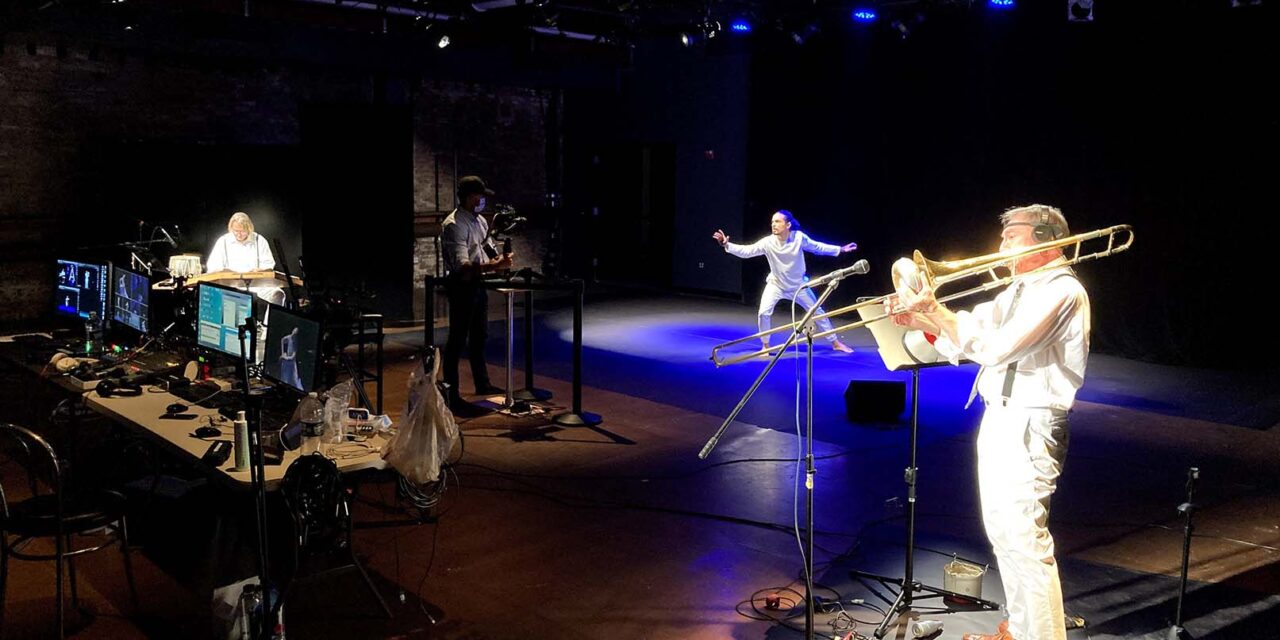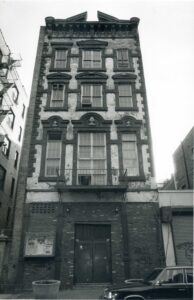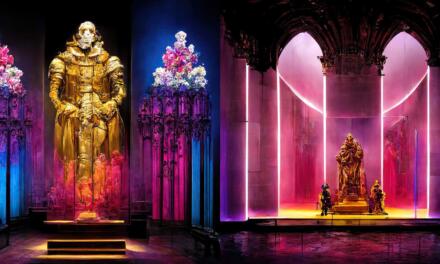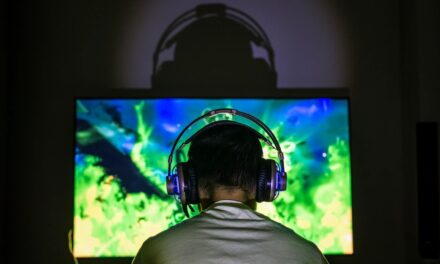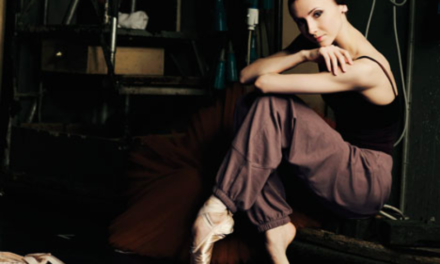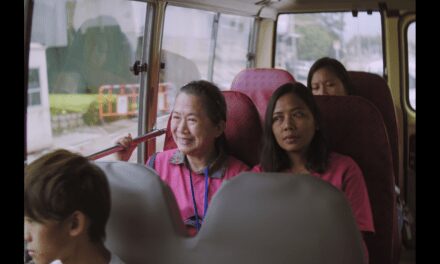Located in graffiti-laden downtown Manhattan where the East Village and NoHo meet at 47 Great Jones Street just off the Bowery—CultureHub—a worldwide art and technology community, is a result of decades of collaboration between La MaMa Experimental Theatre Club and Seoul Institute of the Arts. Proudly multi-disciplinary with roots in experimental theatre and new media, CultureHub’s place in the global art scene remains absolute.
The story of La MaMa’s founder, Ellen Stewart, among the first impresarios to bring a diverse ensemble of artists from around the world to the New York stage and Yoo Chi-Jin (Korean formatting of name family name first), the founder of SeoulArts and his son, Yoo Duk Hyung, founder and true visionary of CultureHub is remarkable. From its in-house technology, LiveLab, to its signature coffeehouse aesthetic and landmark works, CultureHub thrives on process, hybridity, and new forms of art and expression.
Across from the famed CBGB, music venue of rock legends Ramones and Blondie, and on the Bowery thoroughfare, a studio for graffiti art where artists Andy Warhol, Jean-Michel Basquiat, and Keith Haring once thrived, Billy Clark, founding Artistic Director of CultureHub, and I met at Think Coffee at the corner of Bowery and Bleecker Street to talk AI, digital storytelling, and the relationship between immersive technologies and the circulation of art, ideas, and information. Reconnecting the neighborhood to seminal figures of the past, Clark gives an account of CultureHub’s signature downtown mentality and scrappy “coffeehouse” approach to art-making:
“CultureHub wouldn’t exist if not for our founding partners, La MaMa Experimental Theatre Club here in the East Village and Seoul Institute of the Arts in Korea. The two pioneering institutions are closing in on their 60th anniversaries. They are one year apart in age. In the early 1970s, the founder of La MaMa, Ellen Stewart had the opportunity to visit Korea and while she was there, she formed a lifelong bond with the Yoo family. Yoo Chi-Jin, the founder of Seoul Institute of the Arts is one of the most influential playwrights in Korea. He founded the school to develop new training methodologies for contemporary Korean performance. When he passed away, his son Yoo Duk Hyung took over the Institute and over several decades expanded the school to include 15 different disciplines. Seoul Institute of the Arts is the most influential art school in Korea and has been instrumental in laying the foundation that has led to the Korean Wave,” said Clark.
Duk Hyung Yoo and Ellen Stewart 1974. Photo Courtesy: La MaMa Archives
At the onset of the 1960s, Café La MaMa took the theatre world by storm with its signature café aesthetic and culture. Created for playwrights to experiment with new works, the La MaMa space has evolved into two venues between Bowery & 2nd Avenue: Ellen Stewart Theatre & The Downstairs at 66 East 4th Street and the First Floor Theatre & Club at 74A East 4th Street. The corresponding The Great Jones Repertory Company—the theatre company in residence at La MaMa (named after La MaMa’s rehearsal building on Great Jones Street) and the community art space, La MaMa La Galleria at 47 Great Jones Street—continue to bring a diverse ensemble of artists, actors, designers, dramaturges, musicians, and performers together. It was Ellen Stewart’s relationship with Yoo Duk Hyung, President of the SeoulArts for decades and now Board Chair Emeritus that smoothed the path; he is the reason CultureHub exists. Clark gives an account on the founding partner’s vision, energy, and support:
“Yoo Duk Hyung, a theatre director, was experimenting at La MaMa in the early days. Ellen or Mama as she was affectionately called, considered Yoo Duk Hyung to be her son. She had many artistic children but her relationship with Yoo Duk Hyung was special. In 2009 as we launched CultureHub, La MaMa and Seoul Institute of the Arts had been collaborating for over 30 years. Yoo Duk Hyung had this idea to use technology, in particular video conferencing technology, to create a window between Seoul Institute of the Arts and La MaMa; that was the seed for what would become CultureHub. From there we decided that it was best to establish a separate entity, CultureHub, that could grow beyond the relationship between these two organizations and become a global art and technology community that would use the internet to create a more sustainable model for cross-cultural exchange and art-making.”
La MaMa Theatre 74A East 4th Street. Photo Credit: Jonathan Slaff.
He continued, adding,
“This was an extension of what La MaMa was already doing in the analog space. MaMa was jumping on boats, helicopters, camels, and all kinds of transportation that allowed her to create opportunities for interconnection between people from different places and traditions. She was among the first to bring unrepresented voices from around the world to the New York stage. For her, Art was a vehicle for broadening human understanding. So, with that in mind, CultureHub was really designed to be the digital fabric, the digital layer, the connective tissue that could help us sustain and develop new relationships all over the world. But President Yoo was the visionary—extremely forward thinking from the very first moment; he knew that this was going to open up a new door, which would allow artists to meet in an entirely different way. Our intention was always to look for new forms of art and expression.”
Using computer interfaces by means of adding digital elements to a live view, Augmented Reality (AR) enhances surroundings. Shutting down the physical space, Virtual Reality (VR) completely immerses participants into a totally new world. When the actual environment and virtual reality merge vis-à-vis computer-generated objects, Mixed Reality (MR) becomes the palate. Extended Reality (XR) is the term that encompasses all 3 reality technologies (AR, VR, MR). Delving into the subject matter, Clark gives an explanation on the departure of New York space to the use of new stimuli:
“I think when people talk about augmented reality the mind goes immediately to a sort of marketing gimmick where you point your phone at a QR code and a little animated figure pops out of your magazine and tries to sell you something. Most people have limited exposure to augmented reality, which is primarily through cell phones apps but if you really think about the concept of augmenting reality, it can take on a wide variety of forms. Without even knowing it, maybe even before that terminology was really in the public consciousness, that is essentially what CultureHub was seeking to do. We wanted to use technology to augment theatrical space.”
Vitally important to the rise of Off-Off-Broadway, La MaMa is dedicated to the artist and all aspects of the theatre including using technology as a medium.
“In 1961 Ellen Stewart rented a basement on East 9th Street and said to her friends ‘let’s do theatre here.’ She was inspired by young playwrights, Caffe Cino, and the work coming out of the 1960s coffeehouse scene, these pioneers reshaped what types of theatrical space were valid, this led to the Off-Off-Broadway theatre movement. That shift democratized theatre production, moving it away from commercial aims, and generating more inclusive access points to create, produce, and present new work. We are still feeling the ripples of that today. CultureHub grew out of this legacy and it is our hope to continue to provide opportunities for artists to create new types of work in a new contexts relevant to our time. Simply put, you have a black box theatre, which is completely flexible. It’s like a blank canvas for the artist to create within. But what if that flexible space could open a wall to Serbia, to Brazil, to Korea, to Guatemala, to Kenya? What type of work could happen then? Would there be a new type of work that could emerge with that layer in place? I think a lot of our exploration has been about using the internet to augment theatrical space, to add a new layer of possibilities spanning oceans and time zones. What does this augmentation allow artists to do that they couldn’t do otherwise? What relationships will emerge? How will our perspectives shift?” said Clark.
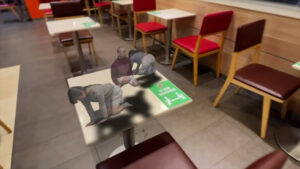
Downtown Variety. Seoul Arts Korea Edition. Photo Courtesy: La MaMa Archives.
On the topic of standout performances and exhibitions that create an overlay of virtual content, Clark provides a picture:
“We just finished our tenth season, and we actually created a book (CultureHub First Decade 2010–2020) that highlights the history of our first decade. We started to excavate our own archives and we uncovered projects I had forgotten about. Sometimes we are working with over 100 artists in a year. I think some of the early works hold a place in my heart because I was learning so much at that point. Coming from a theatre background I still feel like an outsider in the new media and the creative technology field. An early collaborator Baba Israel and I did a series of telematic dance, new media, and music performances between Manchester and New York City. The project was called Digital Duets. Baba is also rooted in all of this history. His parents were part of The Living Theatre. His mother was actually in Nam June Paik’s Good Morning, Mr. Orwell, which was the first satellite performance that linked New York, Paris, Germany, and Korea and was broadcast on PBS to over 25 million viewers. Talk about pioneers, Paik was one of the first to think of media as art and was among the first to use communication technologies creatively.”
Digital Duets. Photo Courtesy: La MaMa Archives.
On an experiment that fused art and technology, Clark continued, adding,
“Another group was E.A.T. Experiment in Art and Technology, which was formed by artists Robert Rauschenberg and Robert Whitman, with engineers Billy Kluver and Fred Waldhauer. It was a collaboration between Bell Labs and experimental, visual, and performance artists. Again this happened in the 1960s. So there is a lineage that allowed us to exist. And interestingly, all the dots connect back to this neighborhood. Robert Rauschenberg’s studio was right around the corner from CultureHub, Robert Whitman was creating happenings up near St. Marks, and Nam June Paik I’m sure was at La MaMa. We had the opportunity to work with Robert Whitman which was such an honor, in fact we have another collaboration, Local Report 2021, which we are working on together now. It sends young artists from Kenya, UK, Korea, Indonesia, Serbia, Portugal, Netherlands, and the U.S. out into their community to report on their surroundings through audio and video clips. All of the media is sent back to CultureHub where we weave it into a media tapestry which will be live streamed as a part of Re-Fest. I think this project, which Whitman has been doing since the 1970s first with New York City pay phones and radio broadcast, will be particularly poignant during the global pandemic. I am curious to see how the piece will illuminate this challenging moment in our history.”
On the aliveness of the neighborhood, the streets are once again a studio for graffiti art. In light of former downtown artists, such as Jean-Michel Basquiat and Keith Haring, Billy Clark spells out what makes the crossroads of NoHo and the East Village at the culmination of the Bowery in New York City so extraordinary and tackles the everlasting question: when does graffiti become art?
“I don’t feel like I am qualified to really speak about graffiti art, but I believe It is an important part of counter culture. Other forms of street art were important too—things like posters, and flyers. I moved to New York City in 1992. At that time there was still a rich tradition of putting up flyers. The East Village was covered in them and many of them were works of art—especially when combined with all the tags, stickers, and other forms of decaying expression. CBGBs, La MaMa, PS122, Theater for a New City, the Pyramid Club, ABC No Rio, etc., etc. All of these underground venues with their punk rock spirit. And how did you get people out to the shows? Well, you made flyers of course, and you posted them all over the neighborhood. There is a whole book that highlights La MaMa’s history through its posters. A new aesthetic emerged that used collage, markers, and new technology because things like the photocopying machine allowed people to actually distribute and disseminate information in a way they couldn’t have otherwise. It was super D.I.Y. or as MaMa would have called it ‘coffeehouse,’” said Clark.
He continued, adding,
“In that sense, it is all related. There is a relationship between the artwork and the street, between the visual art world, the punk scene, and Off-Off-Broadway. CultureHub is situated right next to where Basquiat painted. These interconnected histories are still very present, for example we work with drag and performance artists Agosto Machado who was bouncing between drag shows shows at La MaMa, Caffe Cino, and the whole Andy Warhol scene and so they were all informing each other. Right over there you can see Phebe’s which was sort of the meeting point. Robert Patrick who was another deeply influential playwright who we have had the great fortune to collaborate with sat in Phebe’s and wrote about the characters that worked there and passed through. That play Kennedy’s Children ended up on Broadway. There are so many stories—MaMa would walk out on the street and go, ‘Bob, Honey, I need you to write a play by Wednesday and there’s got to be at least seven roles,’ and she would come out and just commission a work like that. ‘Up by Wednesday!’ And so, the culture, the people, that community vibe and coffeehouse culture was so much a part of what led to this renaissance. Because, you know—when you look at the pioneers of the avant-garde theatre, punk, and digital art, many of them were right here. they were right here—converging on the Bowery.”
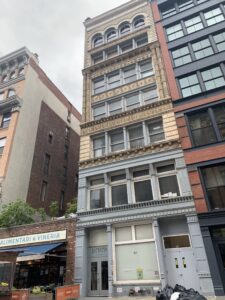
CultureHub 47 Great Jones Street in New York City. Photo By Alexander Fatouros
Uniting under one cohesive message and a collective vision—that is to foster a more sustainable model for international exchange and creativity—Clark sets the scene for the downtown mentality and scrappy coffeehouse approach to art making as a means for broadening human understanding:
“MaMa, would say ‘it’s coffeehouse baby!,’ and what she meant by that is layered. It’s a hard thing to translate. But she was saying that you make do with what you have. And that in a way this poor aesthetic gives you freedom, she always wanted La MaMa to be a poor theatre, maybe to a fault. But, she had her reasons for that. Theatre is really viewed through the lens of Broadway and Broadway being what theatre is. La MaMa’s theatre is non-commercial; it’s not about the next big thing, it’s about the process and relationships. And Mia Yoo the current Artistic Director of La MaMa, who was mentored for years and selected by Ellen Stewart, fully embodies the spirit of La MaMa. She is working to ensure that La MaMa will be around for another 60 years and beyond. And one of her strategies is to embrace technology and the potential that it holds.”
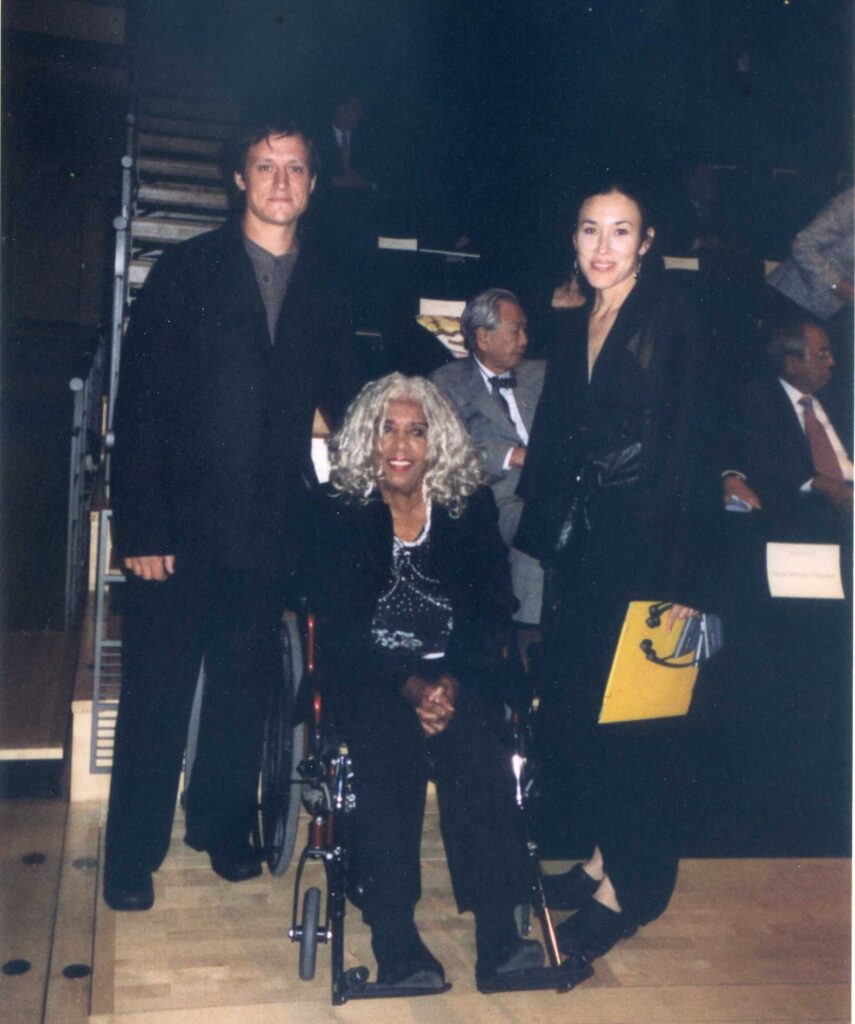
CultureHub founding Artistic Director, Billy Clark, Ellen Stewart, and Mia Yoo, Artistic Director of La MaMa. Photo Courtesy: La MaMa Archives.
Ellen Stewart’s contributions go well beyond creating opportunities for cultural exchange. The juxtaposition between connected environments and subject matter has expanded. The intersection of live performance, music, costume, set, and sound design with Virtual and Augmented Reality platforms continues to vitalize artist expressiveness.
“La MaMa’s flagship building 74A East 4th Street is undergoing capital renovations. The new facility, which is scheduled to open in the fall will be fully networked, allowing the experimental work that we have been pursuing at CultureHub to grow and expand into a new type of theatre venue. One that MaMa might not have been able to imagine but I am sure she would love. The pandemic is expediting this conversation. Because you have a bunch of people who love theatre who are finding themselves without access to it. And they feel like what they’re getting online is sub par. It just doesn’t feel the same. And so the whole discourse around this in the beginning of the pandemic was a lot of pining for what we’ve lost. But I think what’s happening is that the definition of theatre is going through an expansion. And maybe what’s happening online isn’t necessarily theatre at all. Maybe it’s going to be something else completely legitimate in its own right. We are at the very very tip of the iceberg; the very beginning of what it will be. Theatre has thousands of years of history. This new online space is amazing and still in its infancy—but as usual, La MaMa was ahead of the curve embracing these new tools and possibilities for over a decade now,” expounded Clark.
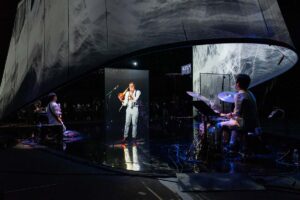
Vital Signs. Photo Courtesy: La MaMa Archives.
Clark characterizes the work of CultureHub, which promotes social change and community participation, ultimately advancing the work of creators in search of new artistic forms:
“Even though we work with a lot of emerging technologies, coffeehouse is still the aesthetic at CultureHub, we love the hybridity. We love the physical space with the virtual space. We like crumpled up paper and cardboard and markers and paint—tangible things next to digital things. And I think that appreciation or that value really comes out of our lineage and it comes out of our history. And is an expression of an ethos, which is that this isn’t for sale and it’s something that is about the process. It’s something that is about what happens when this unique group of collaborators comes together asking questions. And we do that in front of an audience. And we don’t have the answer. And maybe when that synergy happens, you know maybe there are little sparks and enlightenment that progresses on to the next question and the next thing. It is very much about taking risks, making mistakes and not knowing what will happen,” said Clark.
Delivering compelling real-time stories by way of in-house technology is a hallmark of CultureHub’s exhibition of works. One early piece, Digital Duets was a collaboration first initiated by Manchester to New York transplants, Baba Israel and DawN Crandell in the early 2010s.
“DawN had a reoccurring dance improvisation event in New York called Mixed Movement; she wanted to start it up in Manchester with the Contact Theatre community. Baba, who was the Artistic Director of Contact at the time, reached out to me to see if there was any way we could do something over the internet so they could connect with their peers from the NYC scene. Baba and I were loft mates in the 90s out in Bushwick and we had thrown art parties together. He knew what I was doing with CultureHub and from there it led to a series of digital collaborations,” said Clark.
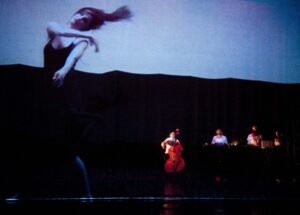
Digital Duets. Photo courtesy: La MaMa Archives.
On the exploration of sound and gesture in relation to visual and performance art, Clark recounts connecting to a world, which encompasses holograms and Computer-Generated Imagery (CGI):
“I mentioned an early work, Digital Duets, in that piece we were projecting onto gauze scrim. I wouldn’t call it a hologram but it was a way creating a deeper sense of presence. We created real and meaningful connections by playing with scale and blending digital bodies with real ones. I would also point to a recent project which is still building on these techniques, a piece we did in September, which again was a multi-year progression that ultimately culminated with a piece called Vital Signs. It was a project with our founding partner, Seoul Institute of the Arts and it was a concert that had musicians in Seoul and musicians here in the downstairs at La MaMa. We used LiveLab, the software that CultureHub has developed over the past 5 years to facilitate the real-time audio and video transmission. In addition to that we were transmitting other types of data between the two venues. The musicians were wearing heart-rate and brain-wave sensors and the data produced by the New York musicians was sent to Korea. These data feeds were affecting audio and visual elements in real time during the production. LiveLab is peer to peer and can transmit audio, video, and data feeds across the world in milliseconds. The performers were projected onto holographic screens so as an audience member in Korea, you would see the New York performers interspersed right there with the live, in person performers,” said Clark.
In a tech-integrated world, the uncoupling between real and virtual is increasingly blurred. From ventures that markedly challenge ideas about medium and process to conceptual ideas influenced by new technological forms for the theatre, CultureHub explores the potential of the human spirit. To keep good company with a global collective of high-profile and emerging artists drop by CultureHub.
This post was written by the author in their personal capacity.The opinions expressed in this article are the author’s own and do not reflect the view of The Theatre Times, their staff or collaborators.
This post was written by Alexander Fatouros.
The views expressed here belong to the author and do not necessarily reflect our views and opinions.

